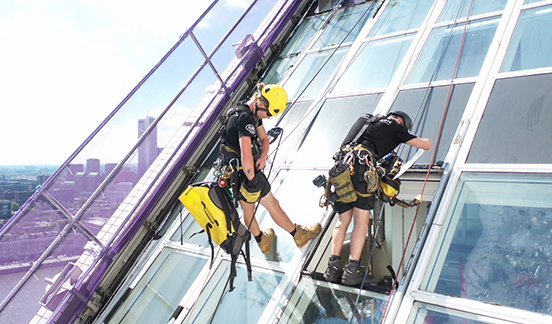Our highly trained staff and special access equipment offer you a proven method of working in a safe position. So our rope access service helps you:
carry out basic inspection, testing and study tasks in hard-to-reach facilities
take advantage of a cost-effective alternative to traditional access methods such as scaffolding or elevated mobile work platforms
carry out your inspections quickly and safely, with minimal interruptions to other servicesWork at height using trusted rope access companies from one of the world’s leading providers
As a leading provider of rope access services, we offer you an exemplary safety record. Our technicians receive extensive training, updated every three years, and an independent evaluation for your complete peace of mind. All of our training and operational work for Rope Access is carried out in line with international guidelines. SGS Singapore is a member of the Industrial Rope Access Trade Association (IRATA) and can assist with projects anywhere in the world to ensure compliance.
Our rope access services include:
inspection and testing of structures
structure studies
conventional and advanced non-destructive testing (NDT) techniquesTransmit to the participants the necessary content to function autonomously and safely in vertical spaces and those difficult to access in different work environments.
Assemble rope runs from safety anchor systems installed by technical operators N2 or higher.
Transmit the techniques and procedures of ascent – descent – transfer – overcoming subdivisions – diversions, and self-rescue techniques in suspension, inherent to the responsibilities of the Level 1 Rope Access Technician under the guidelines of AATTVAC (Argentine Association of Technicians in Vertical and Rope Access), complying with current national and international norms and standards.
Addressed to:
● Workers who wish to incorporate Rope Access skills.
● Workers who work in confined spaces, difficult to access or at risk of falls from a height.
● Professionals in Hygiene, Safety and Quality.
● Firefighters.
● Special rescue groups.
● Civil Defense.
● Trainers.
● Other stakeholders.
Rope access means work carried out at height, using specialized techniques and equipment, using ropes as a means of progression and safety.
This type of work is popularly known as vertical work, although rope access techniques are applied in rescue and other tasks.
The main characteristics of these works are that they are carried out at height, in places that are difficult to access, and that ropes are used as a means of access and also as a means of security.
The vertical works have as premises:
Do not work alone.
Use two independent ropes (work rope and lifeline).
Connect the ropes to at least two independent anchor points.
Use two devices, one for progression and the other for safety.Basic rope access equipment.
The basic kit for a rope access technician or vertical technician consists of:
Helmet.
A helmet for vertical work must be comfortable, protect from impacts from above and from the sides, have a resistant chinstrap (that does not come off easily), be compatible with other protective equipment (glasses, screens, headphones, neck cover, etc.). It must also meet the specific requirements of the work to be performed.
Petzl offers the STRATO® and VERTEX® range modular, with DUAL chinstrap, various colors, and multi-standard certification (CE + ANSI). In addition to exciting features such as the internal collapsible headband (FLIP & FIT), the CENTERFIT adjustment, and the EASYCLIP accessory change system.
rope access helmets and vertical work Vertex and Strato
Integral Harness (with fall arrest, descent, and positioning rings).
It is recommended that you integrate a CROLL-type chest blocker for progression, ascent, and rescue maneuvers.
Suspension and fall arrest harness VS. Harness for difficult access. Both types of Harness meet the requirements for working at height, suspended from ropes:
Dorsal (back) fall arrest ring. Type A (CE 361 approved ISP NCH 1258).
Sternal / pectoral (chest / sternum) fall arrest ring. Type A (CE 361 approved ISP NCH 1258).
Ring for controlled descent (pelvis). Type D (CE 813 approved ISP NCH 1258).
Positioning rings (waist). Type P (CE 358 approved ISP NCH 1258).
Self-braking descender: It must be compatible with the work rope (RIG or IDs).
The Petzl RIG braking descender is compact as it does not have an anti-error or anti-panic system. The RIG is a self-braking descender (AutoLock) for experienced users.
The Petzl ID's self-braking descender has a cam that blocks the rope if it is incorrectly installed (anti-error) and an anti-panic system that stops the descent if the lever is manipulated with excessive force (uncontrolled speed). That is, it is a descender with more passive safety functionalitiesLanyard
With three ropes, to position yourself in the workplace. There are several options:
The classic "cowstail", made with dynamic rope and knots. Popular with IRATA technicians.
Adjustable ropes type PROGRESS ADJUST.
Combination of elements (example coastal + Petzl GILLON).
Petzl GRILLON lanyards, PROGRESS ADJUSTConnectors
The connectors join the elements to each other and the system. There are different types of connectors, but the most used are carabiners (other types would be millions, rings, and structural hooks).
There are simple carabiners (without insurance) and safety carabiners (with insurance). To connect our devices, we will always use safety carabiners.
You also have to differentiate the shape of the carabiner.
The symmetrical ones are the most versatile due to their shape. Ideal for pulleys and good for lanyards and anchors (OK SL or TL for ASAP anchor and fall arrest ropes.)
D-shaped carabiners are very popular for connecting devices such as the descender and lifeline to the Harness. They are also good for anchors (AM'D SL or TL)
Large HMS or Pear type is more specific. In rope access, they are relegated to lanyards and some installations with pulleys or several elements.
